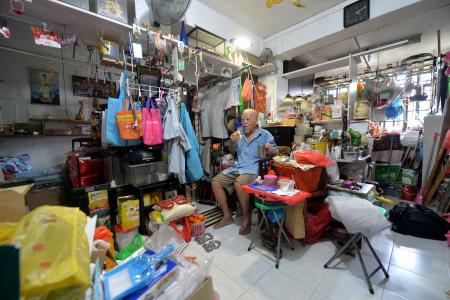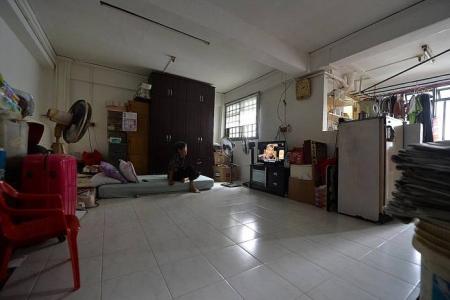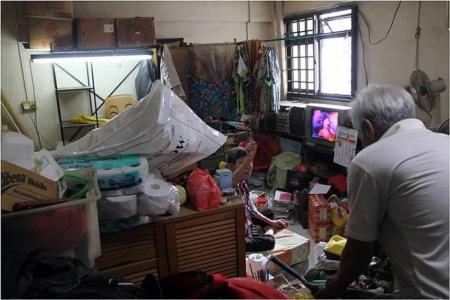Extreme hoarding is a mental illness
When Madam S.L. Yue, then 75, fell in the toilet in 2013, the paramedics took 30 minutes to get her out.
They had to navigate the mountains of plastic bags, boxes, buckets and junk that cluttered the one-room flat she and her brother, Mr F.L. Yee, 76, shared in Geylang Bahru.
That was almost two years ago, and there has been one cleanup by volunteers from the Touch Seniors Activity Centre at their block since.
But when The New Paper on Sunday visited the flat last week, there was clutter again, with only a narrow path snaking through the accumulated items, leading from the entrance to the tiny kitchen area and toilet.
Alongside the path are buckets and dangling plastic bags.
In one corner, we spot bags of rice received from welfare organisations such as Lions Befrienders.
The siblings have opted to save the rice for a rainy day - except the rice has been sitting for so long, the bags are visibly full of weevils.
There is no space to sit, so the interview is done standing up.
At the far end of the room, there is a small space with two mattresses where Madam Yue, 77, and Mr Yee curl up to rest at night.
The problems started when the siblings moved in together in 2005. Before that, they had their own flats, so the move meant both lugged their own possessions in.
"We threw out a lot of things when we moved. Six lorries full of my things. I was left with only two lorries' worth of items," Mr Yee insists.
He is obviously reluctant to get rid of things.
A bit of a handyman, he has a penchant for affixing hooks to any available surface and hangs up various knickknacks.
For instance, he has made makeshift handles, hanging from the ceiling, for them to grip, should they need the support.
He also salvages wooden bits to put together. Tin cans containing tools and nails are tucked against stacks of boxes.
Madam Yue is in the habit of keeping clothes, even pieces from years ago which she no longer wears.
Both are still getting help from Touch volunteers. A spokesman says they are still trying to convince Mr Yee to get rid of stuff.
FOND OF 'YU' THINGS
Says the spokesman: "He is quite superstitious, he keeps quite a lot of fish (yu in Mandarin) items because of his surname Yee. We had to clear a 1.2m-long fish tank blocking his doorway."
When that was cleared away, smaller tanks found their way into the flat, she reveals.
"He still collects things, so now the house is back to square one."
Mr Yee clarifies: "They were passed down to us. We already threw out a lot when we moved.
"My sister is not doing so well now and I have to wait till after my pacemaker surgery, then make arrangements to throw things away. Some of my things, I have to take out slowly, cannot rush. I have to arrange what I want to keep, then throw away the rest."
But Mr Yee has been singing the same tune since the big cleanup of 2013.
"But you still have the energy to add new items," the spokesman says with an exasperated laugh.
Mr Yee says: "Some of my things I have had since before some of you were born. I want to arrange properly before I throw.
"I have to take care of my health before I do all of that."
Despite promises to tidy up, Mr Yee seems happy with his hoard.
He excitedly picks up a long wooden plank with hooks attached, hooks that he has kept for more than 20 years.
"We cannot waste what we have. A lot of the items are made by me. If the item I find is useful, I will collect it," he says with conviction.
Pleased with her newfound floor space
Looking at the clean and bright one-room flat, you would think the owners had just moved in.
But a little under a year ago, the place was a completely different picture. Old, tattered and unopened boxes were stacked up against the walls. Large, dirty buckets were placed haphazardly in the room. Mattresses were infested with bed bugs.
The room could barely fit two adults comfortably, let alone a slew of volunteers ready to clean up the flat.
The turning point came for Madam Tang, 75, when the Touch Seniors Activity Centre at Block 61, Geylang Bahru, offered to help clean up the flat in April last year.
"I am old already, I didn't have the time or the energy to clear it myself," she said.
The Touch spokesman says that it took convincing initially.
They eventually got the consent of Madam Tang and her husband Mr L.L. Koh, 73.
Madam Tang admits that at first, she could not bear the sight of things being thrown away.
"I didn't want to see them clean up. If I did, I would have wanted to keep the things that were being thrown away.
Today, she could not be happier.
"They cleaned up the flat and gave me new furniture. It is spacious, airy and convenient to walk around."
She recalls having to go downstairs for space and fresh air when the clutter got too much back then.
These days, she even takes charge of keeping house.
"I will clean the house myself. Even when I cannot really stand, I will slowly move around and wipe the floor," she says with a smile.
Hoarding out of loneliness, need for comfort
Compulsive hoarding can be symptomatic of a chronic mental illness.
Psychiatrist in private practice, Dr Adrian Wang, explains that people collect what others usually think of as junk in extreme cases of hoarding.
It can start mildly with collecting paper clips, for instance.
Dr Lim Boon Leng, who is also a psychiatrist with his own practice, explains that it is a form of obsessive compulsive disorder.
Sufferers hoard as a source of comfort.
Dr Wang explains: "They may think 'it's just in case, you never know when you may need it'. It is a security blanket, and this behaviour may be more pronounced when the person is stressed."
Dr Lim notes there can be triggers, such as getting evicted, getting divorced or the death of a loved one.
Another major trigger is loneliness.
"The person may hoard out of loneliness for comfort, and they may be lonely because they hoard. It is a vicious circle."
Treatment options include medication and counselling. According to Dr Lim, patients struggle to explain their use when asked why the items they keep are useful. But they face substantial anxiety when it comes to throwing things out.
A single community service group, the Touch Seniors Activity Centre in Geylang Bahru, saw a total of 30 cases in 2014 alone.
Of them, 16 declined cleaning help.
Ms Julia Lee, 52, director of Touch Seniors Activity Centre, says it takes a lot of persuasion.
TAKE FREELY
"We try to start by removing little things and establishing rapport with them," says Ms Lee.
"Some hoarders may like free items, such as rations. They keep but they never use, so there are bags of rice that have been kept for years, to the point of decay."
She adds that others may develop an emotional attachment to the items, based on how they acquired them.
Employees of Seaco, a container-leasing company, volunteered with Touch to clean some of the homes.
A spokesman for Seaco explains: "Some of the units were very dirty and crowded, and after six to ten hours of hard work, the difference is phenomenal.
"We plan to go back and help again. It was challenging but rewarding to see the difference."
The experts feel more can be done to help hoarders here. The issue? Where to draw the line to go in, with or without the consent of the home owner.
"If the patient refuses treatment and is not deemed to be an immediate danger to himself or others, treatment cannot be enforced," says Dr Lim.
He mentions that some countries have Community Treatment Orders, which grant more teeth to medical practitioners to provide help to those who need it.
He thinks that a similar act may allow treatment to be provided earlier to compulsive hoarders.
Meanwhile, his advice to the family members of hoarders is to be understanding.
"It is a medical condition, it requires treatment and we cannot be judgmental as they are not deliberately trying to be difficult."
Cases reported in 12 months
February 2015
TOA PAYOH
A pair of mother, 55, and son, 20, had been hoarding for a decade. The mess spilt over to the woman's mother-in-law's flat. The trash was from floor to ceiling. Neighbours complained of both pests and odour. Both flats were cleaned up in an operation coordinated by the Housing Board, and involving the National Environment Agency, the Potong Pasir Town Council and the police.
January 2015
ANG MO KIO
A dispute erupted when residents spoke of how a hoarder would rummage through recycling bins. She took the items home in a trolley that scraped the ground. The noise gave residents sleepless nights. There was also a stench emanating from her flat. The town council tried to clear some junk in the corridors.
December 2014
KIM KEAT
A man in his 50s was found dead in his three-room flat on Nov 18 at Block 195, Kim Keat Avenue. Yet, neighbours still had to put up with the stench from his flat a month after. The flat was so crammed with rubbish that cleaners had to use a shovel to remove the contents that covered the entire kitchen floor.
October 2014
RIVERVALE
One resident had been hoarding for two years. It took 14 people nearly 10 hours to clear the rubbish.
February 2014
TAMPINES
One resident was reported to have collected rubbish in her flat for years. Plastic bags were piled atop each other and plastic bottles littered the walkway. Neighbours complained of pests invading their homes.
Get The New Paper on your phone with the free TNP app. Download from the Apple App Store or Google Play Store now




